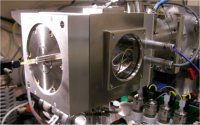Biological Sciences Division
Staff Awards & Honors
August 2009
Ultrasensitive ESI-MS Source and Interface wins R&D 100 Award
Achieving unprecedented analysis levels for human health studies

The Ultrasensitive ESI-MS Source and Interface integrates four technologies to enable a 40-fold increase in the sensitivity of mass spectrometry instrumentation while requiring smaller samples. Enlarge Image

Inventors of the Ultrasensitive ESI-MS Source & Interface from left: Jason Page, Ryan Kelly, Dick Smith, Keqi Tang. Enlarge Image.
When characterizing small, hard-to-acquire samples, scientists need sensitive instruments that can provide highly accurate data. By integrating a combination of inventions and approaches, Pacific Northwest National Laboratory scientists developed the Ultrasensitive ESI-MS Source & Interface. This instrument enables a 40-fold increase in the sensitivity of mass spectrometry instrumentation. And the scientists gained a 2009 R&D 100 Award for their efforts. The awards are given annually by R&D Magazine to recognize the most technologically significant products of the year.
Mass spectrometry instrumentation enables the analysis and identification of broad types of samples and ranges of chemical compounds. It's commonly used for environmental and health analyses, as well as by industry for pharmaceutical and petrochemical product development. The most broadly useful methods for chemical and biochemical samples use electrospray ionization-mass spectrometry (ESI-MS).
Developed by Drs. Richard D. Smith, Ryan Kelly, Jason Page and Keqi Tang, the Ultrasensitive ESI-MS Source & Interface integrates four technologies to provide greater sensitivity and precise measurements while requiring smaller samples. The improved ESI-MS instrumentation can measure amounts of compounds in a sample very precisely, even when very little material is available. This is especially important when sample sizes are limited, such as from microbiopsies of human tissue.
PNNL scientists are using the improved sensitivity in studies to develop biomarkers for early disease diagnosis, drug target discovery and basic biological research. The laboratory is also engaged in a collaboration with a major vendor of mass spectrometry instruments to further explore the benefits of the new ESI-MS system.
The instrument was developed within the Environmental Molecular Sciences Laboratory, a U.S. Department of Energy national user facility at PNNL.
See the PNNL news release.
